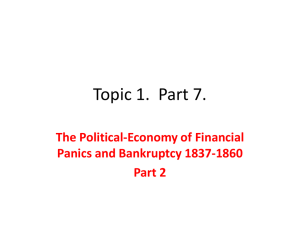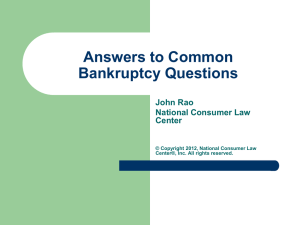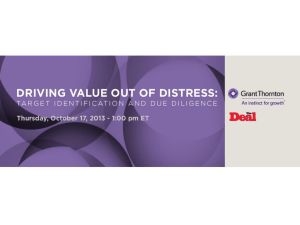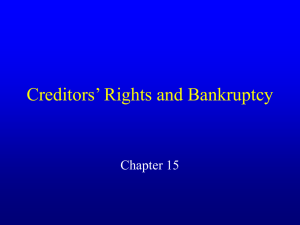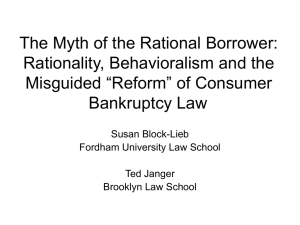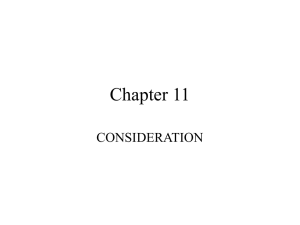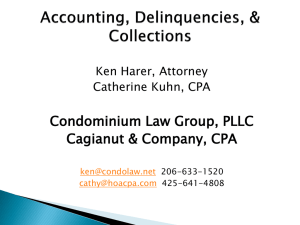Chapter 19 Problems with Credit
advertisement
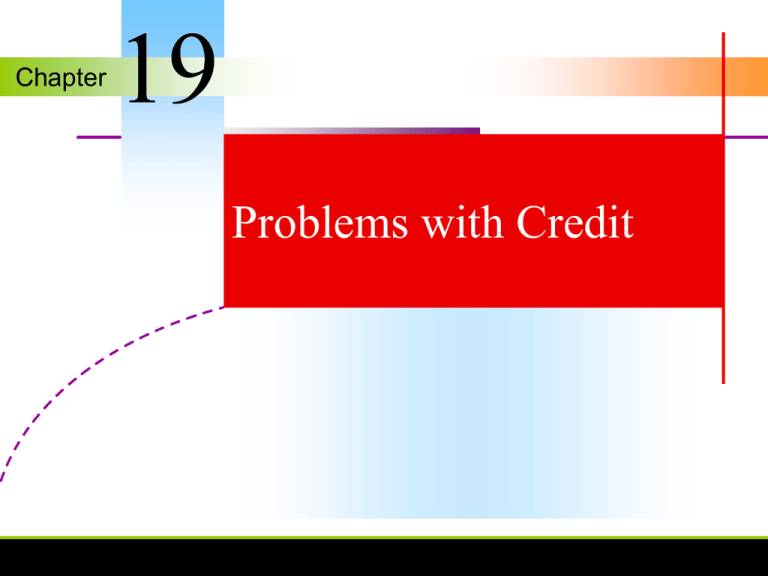
Chapter 19 Problems with Credit The 20/10 Rule The 20/10 Rule is a plan to limit the use of credit to no more than 20 percent of your yearly take-home pay, with payments of no more than 10 percent of monthly take home pay. Mortgage loans and monthly payment commitments for housing are not included in these limits. However, all other types of borrowing are included in the limits of the 20/10 Rule. Chapter 19 SLIDE 2 A Credit Payment Plan A credit payment plan is a record of your debts and a strategy for paying them off. List all debts, with enough information to analyze which ones should be paid off first. Focus on paying one off at a time, while making only minimum payments on others. As one gets paid off, shift your focus to the next priority. A credit payment plan works best when you are responsible and do not incur new debt. Chapter 19 SLIDE 3 Legal Recourse When credit problems arise that cannot be solved by your own actions or through assistance, the final step for relief is bankruptcy. When you are bankrupt, you are unable to meet your bills. Chapter 19 SLIDE 4 What Is Bankruptcy? Bankruptcy is a legal process that relieves debtors of the responsibility of paying their debts or protects them while they try to repay. When you declare bankruptcy, you are said to be insolvent. This means you have insufficient income and assets to pay your debts. Bankruptcy is a second chance, but it carries serious consequences. Chapter 19 SLIDE 5 Bankruptcy Laws and Their Purpose Bankruptcy law in the United States has two goals. The first is to protect debtors (people who owe money) by giving them a fresh start, free from creditors’ claims. The second is to give fair treatment to creditors competing for debtors’ assets. Chapter 19 SLIDE 6 About Personal Bankruptcy Bankruptcy is a court proceeding. Bankruptcy remains on your credit report for 10 years. Each debt that was discharged under the bankruptcy petition (such as credit card accounts) may remain on your report for seven years. You should hire an attorney to file bankruptcy. Bankruptcy Laws and their Purpose Bankruptcy law in the U.S. has two goals: 1. Protect a debtor by giving them a fresh start, free from creditors’ claims. 2. Give fair treatment to creditors competing for a debtor’s assets. Bankruptcy laws treat two general classes of debt: secured and unsecured. Chapter 19 SLIDE 8 Class of Debt With secured loans, the debtor has pledged specific assets as collateral for payment. If the debt is not paid, the creditor can repossess the asset that has been pledged. For unsecured debt, no specific asset is pledged, but all of the debtor’s resources are considered in a bankruptcy action. Chapter 19 SLIDE 9 Types of Bankruptcy Chapter 11 bankruptcy Chapter 7 bankruptcy Chapter 13 bankruptcy Chapter 19 SLIDE 10 Chapter 11 A reorganization form of bankruptcy for businesses that allows them to continue operating under court supervision as they repay their restructured debts. Existing management retains control of a business unless a trustee is appointed by the court. The trustee is a person who will oversee the assets of the business and file court reports. The main purpose: reorganize their debt structure Chapter 19 SLIDE 11 Chapter 7 Bankruptcy For individuals, there are two basic ways to file bankruptcy: Chapter 7 or Chapter 13. Chapter 7 Bankruptcy is a liquidation form of bankruptcy for individuals. (Commonly called straight bankruptcy.) Debtors must give up all their property except for certain exempted items. The advantage of Chapter 7 bankruptcy is immediate debt relief. Recent bankruptcy laws make it more difficult for a person to qualify for straight (liquidation) bankruptcy. Chapter 19 SLIDE 12 Exempted Property Exempted property is an asset or a possession that the debtor is allowed to keep because it is considered necessary for survival. Federal and State laws allow a number of items to be exempted such as: Some equity in a home $3,200 for a motor vehicle Items worth up to $200 each Some jewelry/tools/books Proceeds from life insurance; unemployment; pensions Chapter 19 SLIDE 13 To file bankruptcy you must also provide: a copy of your latest tax return for a Chapter 7. past 4 years’ tax returns for a Chapter 13. a certificate of credit counseling. evidence of earnings in the past 60 days. monthly net income and any anticipated increase in income. a photo ID. The Court appoints a trustee The trustee arranges for the sale of your non-exempt property and is responsible for paying as many of your debts as possible with the proceeds. • Not all debts can be erased by bankruptcy. Chapter 13 Bankruptcy Chapter 13 bankruptcy is a reorganization (payment plan) form of bankruptcy for individuals. It allows debtors to keep most of their property and use their income to pay a portion of their debts over three to five years. Under Chapter 13, often referred to as the wage-earner’s plan, some debts are totally discharged, but family obligations still remain for child support and alimony. Chapter 19 SLIDE 16 Key points You can only file bankruptcy under one category at a time. Chapter 7 offers a financial fresh start and is a quicker process compared to a Chapter 13. A means test will determine if you are eligible to file Chapter 7 or repay part of your debt under a Chapter 13. Pre-bankruptcy credit counseling and pre-discharge debtor education are bankruptcy requirements. Chapter 7 can be filed only once every eight years. You cannot file Chapter 13 if you obtained a bankruptcy discharge in the past 2-4 years. Repercussions of Bankruptcy When you file Chapter 7 bankruptcy, all your property except exempt assets will be sold to pay your creditors. • An exempt asset is property you are allowed to keep during bankruptcy. If you file a Chapter 13 repayment plan, it will take three to five years to repay your debts and receive your discharge from the court. Bankruptcy will not remove: Child support and alimony Debts for personal injury or death that you caused while under the influence of alcohol or illegal drugs Student loans Fines and penalties for law violations, such as traffic tickets, court-ordered payments or recent property tax assessments. Income taxes from the past three years and other tax debts Credit purchases of $1,150 or more for luxury items within 60 days of filing (continued) Bankruptcy will not remove: (continued) Loans or cash advances of $1,150 or more taken within 60 days of filing Debts owed to a single creditor of more than $500 for luxury goods purchased within 90 days of filing Cash advances of $750 made within 70 days of filing Debts or judgments based on fraud or other illegal activities Criminal restitution resulting from illegal activities Debts you owe from a divorce decree or settlement Any debts you forgot to list in your bankruptcy filing Key Points Bankruptcy remains on your credit report for up to 10 years • This can make it difficult to get new credit, find a place to rent, get insurance or qualify for some jobs Unless you change your financial habits after you file bankruptcy, you might fall into debt again To Declare, or Not to Declare? Bankruptcy is not a way to avoid debts you can afford to pay but just don’t want to pay. Bankruptcy will not allow you to keep your house and cars if you have a mortgage or car loan unless you pay your creditors. Bankruptcy will immediately stop most collection efforts against you. Creditors can’t take further action against you unless they obtain permission from the bankruptcy court. Major Causes of Bankruptcy Business failure / Job loss Emotional spending Failure to budget and plan Catastrophic injury or illness Chapter 19 SLIDE 23 Advantages of Bankruptcy Debts are erased. Exempted assets are retained. Exempted property refers to those assets considered necessary for survival. Certain incomes are unaffected. The cost is small. Chapter 19 SLIDE 24 Disadvantages of Bankruptcy Credit is damaged. Property is lost. You may not qualify for liquidation. Some debts continue. Some debts can be reaffirmed. Co-signers must pay. Chapter 19 SLIDE 25 Credit Cards Will I be able to get a new credit card? • You might have trouble getting a regular credit card, but you will probably qualify for a secured credit card if you put money in a savings account to guarantee the card. Banking Can I open a bank account? • Unless you have abandoned a bank account while owing money, bounced checks you never paid back or had a bank account closed on suspicion of fraud, you should have no trouble opening a new bank account subsequent to filing bankruptcy. Current Employment Will bankruptcy affect my job? • The Bankruptcy Code specifically prohibits employers from discriminating against current employees who file bankruptcy. • The law applies to private and government employers. Looking for work If you look for a new job while the bankruptcy is still listed on your credit report, potential employers may choose to reject you. There is no law to prevent this from happening. Re-establishing Credit A Chapter 7 bankruptcy will stay on your credit report for 10 years. • Home and auto loan and credit card applications may ask if you’ve declared bankruptcy, and your answer may be a factor in the lender’s decision. • You may be able to qualify for a mortgage or car loan at a higher-than-average interest rate. You should be able to qualify for a secured credit card if you deposit money in a bank account to guarantee the card.
